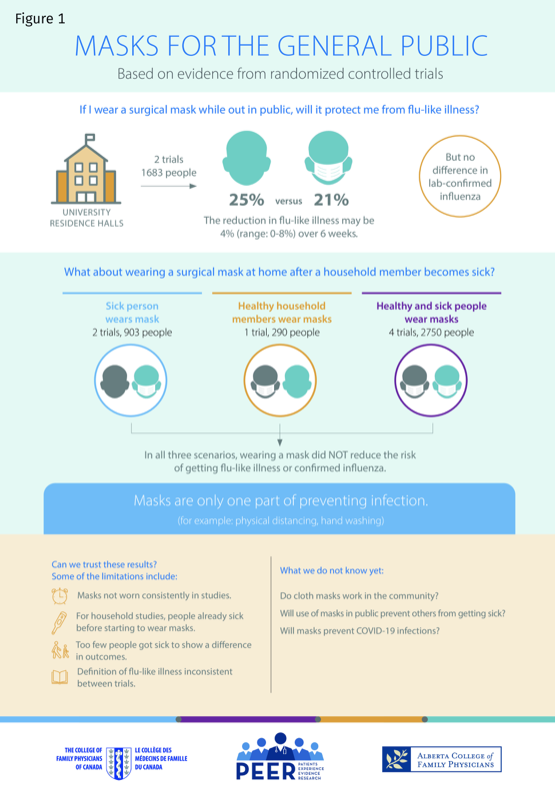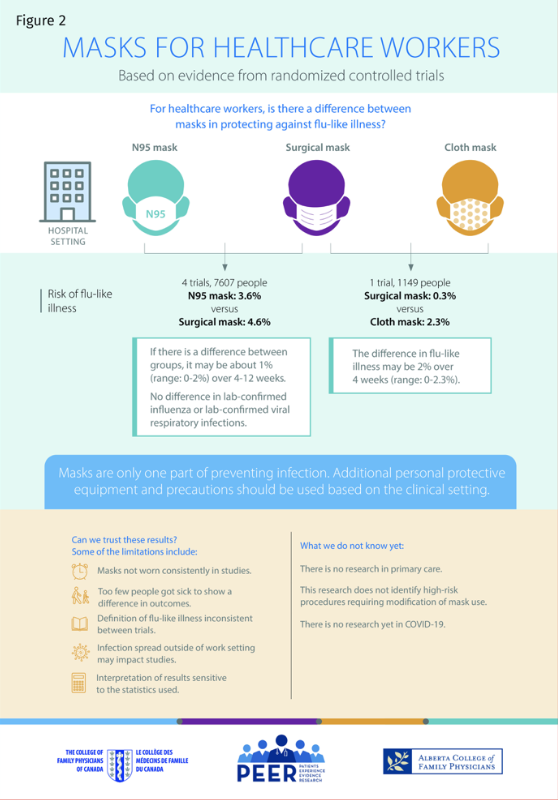The mainstream narrative will have you believe that “the science” of mask use is a decided issue with airtight randomized controlled trials by the dozens available in the literature showing efficacy in many environments for both the public and health care workers. A review of the available literature below says that is not the case. Randomized controlled trials are FEW and much is to be left to discovered on the matter of mask use especially as it relates to COVID-19. -FPS
Moe S, Dugré N, Allan GM, Korownyk CS, Kolber MR, Lindblad AJ, Garrison S, Falk J, Ton J, Perry D, Thomas B, Train A, McCormack J. PEER simplified tool: mask use by the general public and by health care workers. Can Fam Physician. 2020 Jul;66(7):505-507. PMID: 32675097; PMCID: PMC7365157.
The purpose of this simplified tool is to share the findings of the PEER (Patients, Experience, Evidence, Research) umbrella systematic review on mask use by Dugré et al.1 The first page of the simplified tool summarizes findings for mask use by the public (Figure 1), and the second page summarizes findings for mask use by health care workers (Figure 2). An easy-to-print version of the tool is available from CFPlus.*


How was this simplified tool developed?
The content in the simplified tool is derived from the PEER umbrella systematic review of systematic reviews, which evaluates and meta-analyzes randomized controlled trials based on clinical similarities.1 It focuses on results that are clinically meaningful to patients or health care workers.
Results were evaluated with attention to interpretation of effect estimates and confidence intervals rather than strict statistical significance.2,3 To do this, the absolute risk of events was calculated by pooling the control event rates from the original trials and applying the cluster-adjusted meta-analyzed risk ratio to obtain the event rate in the treatment group.1 The absolute risk difference is reported with the 95% confidence interval to explain the range of possible effects.
Context and limitations
An important consideration when interpreting the mask literature is understanding that there are studies that have not yet been done, and that there are limitations of studies that have been done. No randomized controlled trials identified widespread use of masks by the public, as recommended by some countries during the coronavirus disease 2019 (COVID-19) pandemic. The closest studies were done on small clusters of university residence halls during influenza seasons.1 Randomized controlled trials of mask use by health care workers were limited to hospital settings, with no trials done in primary care settings or other outpatient settings. Our review did not look at mask use during specific high-risk procedures that warrant modification of mask use (eg, intubation). No studies evaluated the effect of mask use on prevention of COVID-19 infections. The trials done to date are limited due to low event rates, variable mask compliance, and high risk of bias. Further limitations are summarized in the simplified tool.
This simplified tool is not a guideline; rather, the information is presented to promote application informed by the best available evidence.
